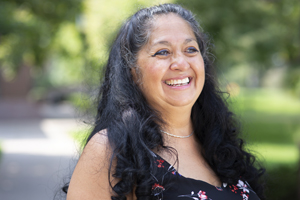Beyond Breathlessness: Coordinated Care Helps Patient Regain Life
 “Just breathe,” Christina Chavez would tell herself. This basic function that most people take for granted didn’t always come easily to the 57-year-old Colorado Springs resident. To help with her shortness of breath, she used oxygen most of the day, every day.
“Just breathe,” Christina Chavez would tell herself. This basic function that most people take for granted didn’t always come easily to the 57-year-old Colorado Springs resident. To help with her shortness of breath, she used oxygen most of the day, every day.
Her primary care physician didn’t know what was causing Chavez’s low oxygen levels. “They didn’t really try to find out anything,” she said. “They just told me to lose weight.” Even though her breathlessness prevented her from exercising, she lost 20 pounds. But nothing changed — until she went to National Jewish Health and Saint Joseph Hospital.
“I started seeing a new doctor who said, ‘I’m sending you to National Jewish Health. They’re the No. 1 respiratory hospital in the nation. I’m sure they can get to the bottom of this,’” Chavez said. “I was on board.”
Getting to the Root of the Problem
Chavez saw Michael Mohning, MD, a pulmonologist at National Jewish Health. She shared her concerns that her job at an electronics plant was causing her health issues. “Finally, somebody was listening to me,” she said. Dr. Mohning assured Chavez that her breathing problems were not work related and began the process of figuring out what was behind them.
After a series of tests determined her heart was not the problem, Dr. Mohning focused on Chavez’s lungs. A CT scan showed she had pulmonary arteriovenous malformations (AVMs) with shunting. This rare abnormality of the lung occurs when unusually dilated vessels provide a right-to-left shunt, or passageway, between the pulmonary artery and vein.
Arteries typically feed into capillaries, smaller vessels which slow blood flow and allow for exchange of nutrients and gases between the blood and organs. With an AVM, arteries and veins are directly connected. Without capillaries between them, gas exchange is reduced, causing lower oxygen levels and shortness of breath — especially with exertion. Clots or bacteria that capillaries would normally catch can pass through the AVM to the blood vessels of the brain and cause a stroke or brain abscess.
Complex Surgery, Coordinated Care Restore Lung Function
Chavez had AVMs throughout her lungs, but three large ones posed the biggest danger. An interventional pulmonologist was able to repair one of them through an outpatient procedure. “I still had two big holes on the right side of my lung,” Chavez said. John Mitchell, MD, a cardiothoracic surgeon at Saint Joseph Hospital, removed the right upper lobe of her lung, ridding her of the two shunts and greatly improving her lung function.
“Both Dr. Mitchell and Dr. Mohning were awesome,” Chavez said. “The communication between National Jewish Health and Saint Joseph Hospital went very smoothly. Those places are awesome. They’re angels there.”
Chavez’s surgery was a success. “I feel so much better,” she said. “My oxygen was so low before, but it just felt normal to me. When I started to get so much more oxygen, it was almost overwhelming.”
Never Too Late to Get Your Life Back
Although Chavez still occasionally relies on oxygen, her daily usage has dropped from 6-7 liters to 1.5-2 liters. It’s easier to work now, she said. In fact, it’s easier to do everything.
Chavez doesn’t have to take oxygen to work or to the mountains on camping trips with her family. She can go on motorcycle trips with her husband now. “I’m still young enough to enjoy life with him,” she said.
“If I hadn’t gone to National Jewish Health and Saint Joseph Hospital, I’d probably still be on oxygen and would have eventually had a stroke,” Chavez said. “I wish I’d gone sooner, but it’s never too late. I got my life back.”

